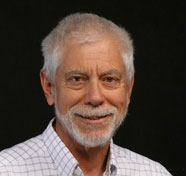

Remapping America: Bill and Cathy Pardee
By Robert Wolf
Decorah, IA, USA

Robert Wolf
One gifted and self-reliant couple has created an entirely new life for themselves, moving from California to northeast Iowa at a time of life when most couples are thinking of "taking it easy." Bill and Cathy Pardee took stock of life in southern California and decided to leave. They also decided they wanted to live on the land, and farm.
Bill Pardee grew up in rural northeast Iowa, in a small town where the family raised turkeys and chickens, and grew several acres of fruits and vegetables. Bill was awarded a scholarship to Iowa State University, where he majored in physics and graduated first in his class. He earned his doctorate in physics at the University of Illinois and subsequently worked as a research scientist for Rockwell. There, he says, he rose "to be Principal Scientist in two different departments: one dealing with materials science and, later, one that focused on information sciences." Bill left Rockwell in 1992 "to become a consultant to engineering companies."
Cathy Pardee was born in California and grew up in southern California, New Mexico, and Texas. She says that in the Southwest, "I developed an absorbing eye for landscapes of open land, big sky, grazing cattle and horses." She and her father raised Appaloosas and Quarter horses, and as a teen, Cathy competed in horse shows and rode the rodeo circuit. She raised her children in southern California, in a horse community, for twenty years. "I always hoped," she said, "to have a small farm or ranch in my later years. As life became more complicated in southern California, I dreamed of a simple life style and open space."
ROBERT WOLF: Why did you decide to leave California?
BILL PARDEE: We saw the paralyzing congestion in Southern California. Also the vulnerability to disasters: drought, earthquake, mudslides, fire—not to mention the high cost of energy and the vulnerability to shortages.
CATHY PARDEE: I also watched the Oxnard Plain (located just a few miles away) from 1965-2007 die from salinization due to irrigation, pesticides, suburban sprawl. One farmer at a time sold off the most productive piece of land of its size in the US to housing developments. The State government was in shambles and we were observing the deterioration of California on many levels.

Bill and Cathy Pardee
ROBERT WOLF: How did you decide to buy land in northeast Iowa? When did you buy your property? How many acres do you own?
CATHY PARDEE: We studied a number of possible locations for a property free of the need for irrigation, exposure to pesticides, with good soil for growing some of our own food. It needed to be a locale free from urbanization, a community with a "spirit of place," that would endure in hard times. It needed to have a college, a good organic grocery store, a welcoming acceptance of new citizens. This community was found after visiting a number of communities in other states that didn't meet all of our requirements.
BILL PARDEE: Northeast Iowa was not an obvious choice. In December of 2005, we wrote a half page, single-spaced vision of our desired, more sustainable, rural life five years later. We wanted a college town—we wanted it to be roughly 5,000 people. We wanted to be part of a community. We wanted access to high quality medical care, recognizing that we won't always be so young and healthy!
We visited northeast Iowa because I remembered the Driftless Region fondly. We started in Dubuque and moved north along the Mississippi to La Crosse, then back down, discovering Decorah only by accident. We hadn't seen anything suitable until we reached Decorah. This was in April 2006.
We went home to do remote research, but we continued to explore other areas—traveling to Tennessee, North Carolina, and Virginia where we sought out and visited Joel Salatin whose work on building healthy soil by rotational grazing had impressed us.
We bought this land in November of 2006.
CATHY PARDEE: We bought thirty-nine acres, lived on it in an existing farmhouse for two-and-a-half years until our new home was completed. We sold the old farmhouse with ten acres and now have twenty-nine acres.
ROBERT WOLF: How would you describe restorative agriculture? How long have you been practicing it?
CATHY PARDEE: Restorative agriculture is focused on the health of the soil first and foremost. There must be no use of pesticides, herbicides, industrial practices—all of which destroy the natural organisms within the soil. Organic animal manure must be produced by animals living on the land and returning nutrients to it. No overgrazing. This allows grasses and weeds to develop deep roots to hold the soil—preventing erosion—and contributes to the feeding of natural organisms living in the soil.
BILL PARDEE: Restorative agriculture is a process of increasing the health and fertility of soil by supporting the natural micro-biological mechanisms. Fertile soil is much more than dirt with some chemicals added. It has a diverse micro-biology.
Moving bunched herds of large ruminants over the grass increases soil fertility more than anything else known to me. Moving the herd, as it did naturally to avoid predators, allows the grass to recover after grazing. The manure, laden with organic matter and healthy bacteria, adds to the biological life of the soil. Micorrhizal fungi, earthworms, and many other life forms thrive and make the soil more fertile. The process, both the addition of poop and the actions of the biological life, adds organic matter to the soil, sequestering large amounts of climate changing CO2 and enabling the soil to absorb and slowly release more rain.

Pardee home and garden
We avoid tilling the soil as much as possible, because tilling allows oxidation of the soil's organic matter and disrupts the structures that deliver air and nutrients to the plants. The micorrhizal fungi extend the root system of the plants to make available more nutrients. The focus of contemporary agriculture on the chemistry of the soil misses the vital contribution of biology to make the useful soil chemicals available to the plants. Chemical fertilizers are believed to make the plants dependent, weakening the natural biological mechanisms.
Our cattle remain outside all year, using trees and a tiny valley for shelter from the wind. We feed grass from May through November, and hay in the remaining months. Their manure in the winter pasture falls heavily around the hay feeders. In the spring, we "mine" that manure to add to our compost pile, which we allow to compost for a year and then add to our gardens to improve its soil, too.
We've also planted trees—maples and oaks and walnuts and fruit trees—in part because the interface between trees and pasture—savannah—is not only beautiful but a biologically healthy climate for many species, including deer and birds and some we don't want, such as gophers and raccoons. We have been doing increasingly sophisticated versions of restorative agriculture since our first summer here in 2007.
CATHY PARDEE: I have been practicing [gardening] this since I created a rose garden in southern California in the 1990's. Though I had little animal manure (I used bat guano), I added composted fruit and vegetables and mushroom compost. I made compost tea of all organic nutrients to foliar feed the roses. I did not dig and turn the soil. All feed was top-dressed. Now, I didn't know the term "restorative agriculture," but I knew I was creating healthy soil, which then produced healthy plants that didn't require chemical sprays. Since the day we moved to Iowa, of course, we've been all organic and focused on restoring the soil. We have purchased and read many books on the subject.
ROBERT WOLF: What are you raising and how do you manage your land?
CATHY PARDEE: We raise Irish Dexter cattle, some vegetables, fruit trees, and garden plants.
BILL PARDEE: In our first two years, we raised meat chickens, also. They were good, and we sold some without difficulty. The cost of buying organic feed was discouraging, and it didn't seem sustainable. I also wore out butchering them, myself.
We manage the cattle grazing by providing a paddock that they can consume in one to three days, and then we move them to a different paddock. We use electric fences. We don't return them to a paddock until the grass has regrown. If cattle graze a pasture continuously, they return again and again to the tender shoots as they begin to regrow, eventually destroying the pasture. If the grass is allowed to regrow—typically requiring three weeks in the spring—the soil and the grass grow healthier and stronger. It absorbs rainfall more easily and it holds it longer.
When the grass grows too fast for the cattle to keep up, I mow it with the tractor. This adds the grass clippings to the soil, and it also has been an effective and natural tool to reduce annual weeds. I have also used a scythe or garden knife to cut or dig out certain obnoxious weeds as I walk across the pastures. An ancient Chinese proverb says that no fertilizer is better than the footsteps of the farmer. We use no chemical weed killers or pesticides.
ROBERT WOLF: What were your preparations for farming? Did you have any farm or ranch background before coming to the Driftless region?
BILL PARDEE: I had only my experience gardening and raising poultry forty years earlier with my father. But I can read, and I sought advice. The lack of experience, though inconvenient at times when I struggled with machinery tasks that any twelve-year-old farm boy could do easily, left me open to novel approaches. I had never lived on a farm.

Cattle in paddock
ROBERT WOLF: In what other ways are you practicing self-reliance?
BILL PARDEE: Our house is well-insulated and well-sealed. The house is heated and cooled geothermally. We installed a photovoltaic array, grid connected, that supplies about 60% of our energy. We also work to reduce that remaining 40% by, for example, moving to low energy LED lighting. We have a gasoline powered emergency generator that provides water, lighting, refrigeration and very limited cooking capability.
CATHY PARDEE: We have timber on our property and occasionally heat the upper level [of our house] with a Rumford fireplace. The Rumford design is the only traditional fireplace that provides efficient heat to the interior. We are now growing some vegetables, fruits and nuts, and we have plenty of room to expand those crops as needed.
BILL PARDEE: We have, at times, employed high school or college students to help with building our gardens and our fences. We learn and plan to do more and more of garden and farm maintenance and repair by ourselves. I am learning to do more machinery maintenance for the farm and the house, myself, though I find this unappealing.
ROBERT WOLF: Do you have anything else to add?
BILL PARDEE: We have built a relationship with this land and our herd. As in a human relationship, as we change the land and care for our cattle, the land and the cattle change us. I have a closer, deeper appreciation for nature than I have ever experienced or realized possible. The appreciation of a farmer, or grazier, for his or her land is much different from that of a hiker or hunter. We are connected to the land, to this place. To a grazier, watching grass grow IS exciting!
We see an enormous variety of birds—eagles, hawks, redwing blackbirds, and on and on—drawn here by the variety of ornamental perennials in our garden and the mice that are exposed when I mow a pasture. We both find this beautiful. We see the personalities of our individual cattle and their connections to each other and to us, giving me a new meaning to spirituality. This shared project has deepened our relationship with each other, and our shared appreciation of nature gives us both joy. For me, after a career doing very intangible things, the process that connects me to nature, appreciating its complexity and beauty, and of growing healthy food for ourselves and for others provides deep satisfaction.
Links:
Robert Wolf
Free River Press
American Mosaic Radio with Robert Wolf





